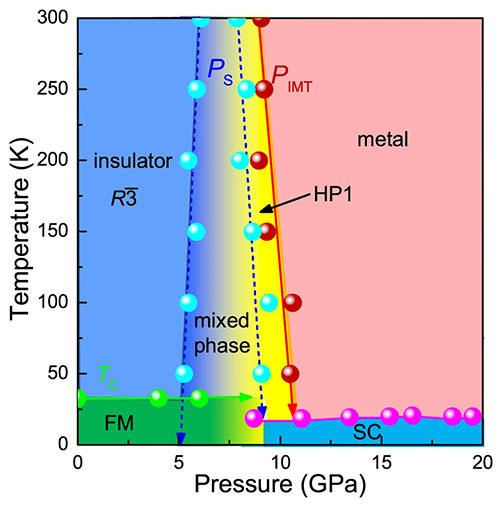Revealing the Phases of CrStTe3 Under Extreme Conditions
Scientists study a "van der Waals solid" under ultra-high temperatures and pressures
August 16, 2023
 enlarge
enlarge
Temperature-pressure (T - P) phase diagram depicting structural, magnetic, and electronic properties of CrSiTe3. Image credit: J.L. Musfeldt, D.G. Mandrus, and Z, Liu. npj 2D Materials and Applications, 7 28 (2023)
The Science
By measuring the far infrared response of CrSiTe3 under extreme temperature-pressure conditions, scientists completely revise the T-P phase diagram of this van der Waals solid.
The Impact
This work helps uncover the mechanism of pressure-driven superconductivity in CrSiTe3, which is of great interest to scientists due to the intriguing and often competing electronic and magnetic states in this class of materials.
Summary
A class of materials called van der Waals solids are of interest to scientists due to their intriguing and often mysterious properties, such as remarkable temperature-pressure phase diagrams and competing electronic and magnetic states. One group of van der Waals solids, the chalcogenides, have been the focus of many studies, with scientists using this class of materials to unravel the relationship between charge, structure, magnetism, and function.
One key approach to understanding the inner workings of quantum materials has been the application of external stimuli. Specifically, under high pressure the chalcogenides display a wide array of behaviors, including insulator-to-metal transitions, piezoelectricity, and even superconductivity.
At the National Synchrotron Light Source II, a U.S. Department of Energy Office of Science User Facility located at Brookhaven National Laboratory, a group of researchers has investigated one of these layered chalcogenides: CrSiTe3. This material exhibits pressure-induced superconductivity, but a clear picture of the structural transition and the relationship between these distortions and the pressure-induced insulator-metal transition is not understood. To explore how superconductivity arises in CrSiTe3, these details must be uncovered.
To gain some insight, the group measured the material’s infrared response under pressure at the NSLS-II Frontier Infrared Synchrotron Spectroscopy (FIS) beamline. They placed their sample within a diamond anvil cell, a device that uses the polished faces of diamonds to apply ultra-high pressures, and then placed the cell in the path of a beam of infrared light. Simultaneously, they cooled the crystal to different temperatures. They were looking to glean key information from the lattice vibrations, or phonons, activated by the infrared light.
The group followed the evolution of the phonons as the sample crossed a broad structural transition and then entered a metallic state. They made several unexpected findings that were counter to previous studies, and which ultimately revised the entire pressure-temperature phase diagram for CrSiTe3. Most notably, the team revealed that a pressure-induced structural phase transition is triggered before the insulator-to-metal transition leading to a nexus of activity at low temperature that may hide a quantum critical point.
This study is a step toward unraveling the events that trigger superconductivity in CrSiTe3. More broadly, being able to control and understand the behavior of the chalcogenides under pressure could lead to exciting advances in high-performance photoresponsive devices.
Download the research summary slide (PDF)
Contact
Jan Musfeldt
University of Tennessee - Knoxville
musfeldt@utk.edu
Publication
Musfeldt, J.L., Mandrus, D.G. & Liu, Z. Insulator–metal transition in CrSiTe3 triggered by structural distortion under pressure. npj 2D Mater Appl 7, 28 (2023). https://doi.org/10.1038/s41699-023-00389-x
Funding
J.L.M. was funded by the Physical Behavior of Materials, Basic Energy Sciences, U.S. Department of Energy (Contract number DE-SC0023144). D.M. acknowledges support from the Gordon and Betty Moore Foundation’s EPiQS Initiative, Grant GBMF9069. Work at the National Synchrotron Light Source II at Brookhaven National Laboratory is funded by the Department of Energy (DE-AC98-06CH10886). Use of the 22-IR-1 beamline is supported by COMPRES, the Consortium for Materials Properties Research in Earth Sciences, under NSF Cooperative Agreement EAR 1606856 and CDAC (DE-NA0003975).
2023-21613 | INT/EXT | Newsroom









